Annotated Bibliography: Addressing Intercultural Team Communication
VerifiedAdded on 2023/06/06
|7
|1552
|298
Annotated Bibliography
AI Summary
This annotated bibliography focuses on the challenges of intercultural team communication, particularly in global business environments. It includes annotations of five key articles addressing various aspects of this issue. The first article explores the connection between language and culture, highlighting how linguistic differences can lead to misunderstandings. The second examines the complexities of technical communication across multiple global locations. The third discusses the unique difficulties in managing culturally diverse teams virtually. The fourth connects leadership styles and communication approaches to team outcomes. Finally, the fifth article emphasizes the importance of understanding and adapting to different cultural viewpoints in the workplace. Each annotation summarizes the article's main points, research methods, and relevance to addressing communication problems in organizations like YLIME.
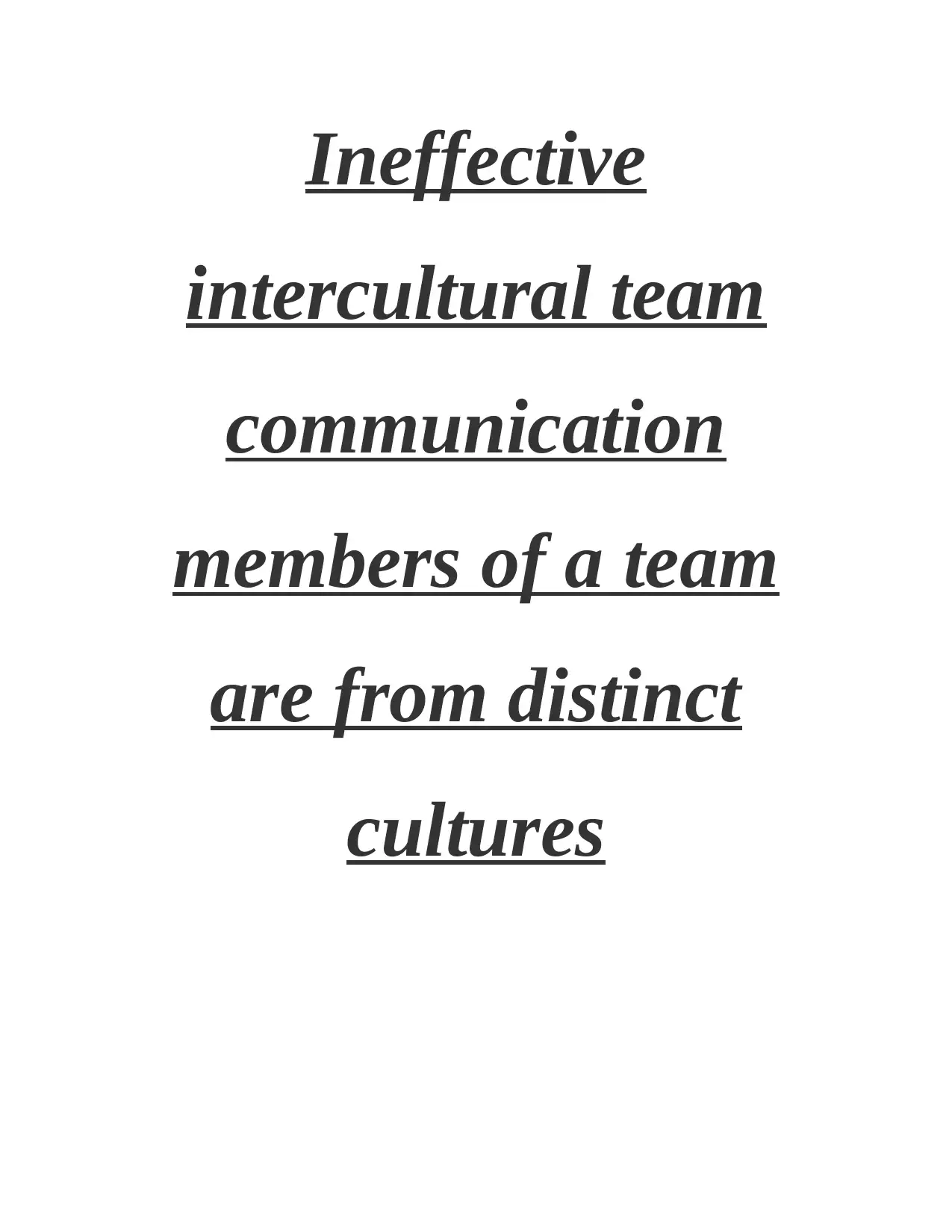
Ineffective
intercultural team
communication
members of a team
are from distinct
cultures
intercultural team
communication
members of a team
are from distinct
cultures
Paraphrase This Document
Need a fresh take? Get an instant paraphrase of this document with our AI Paraphraser
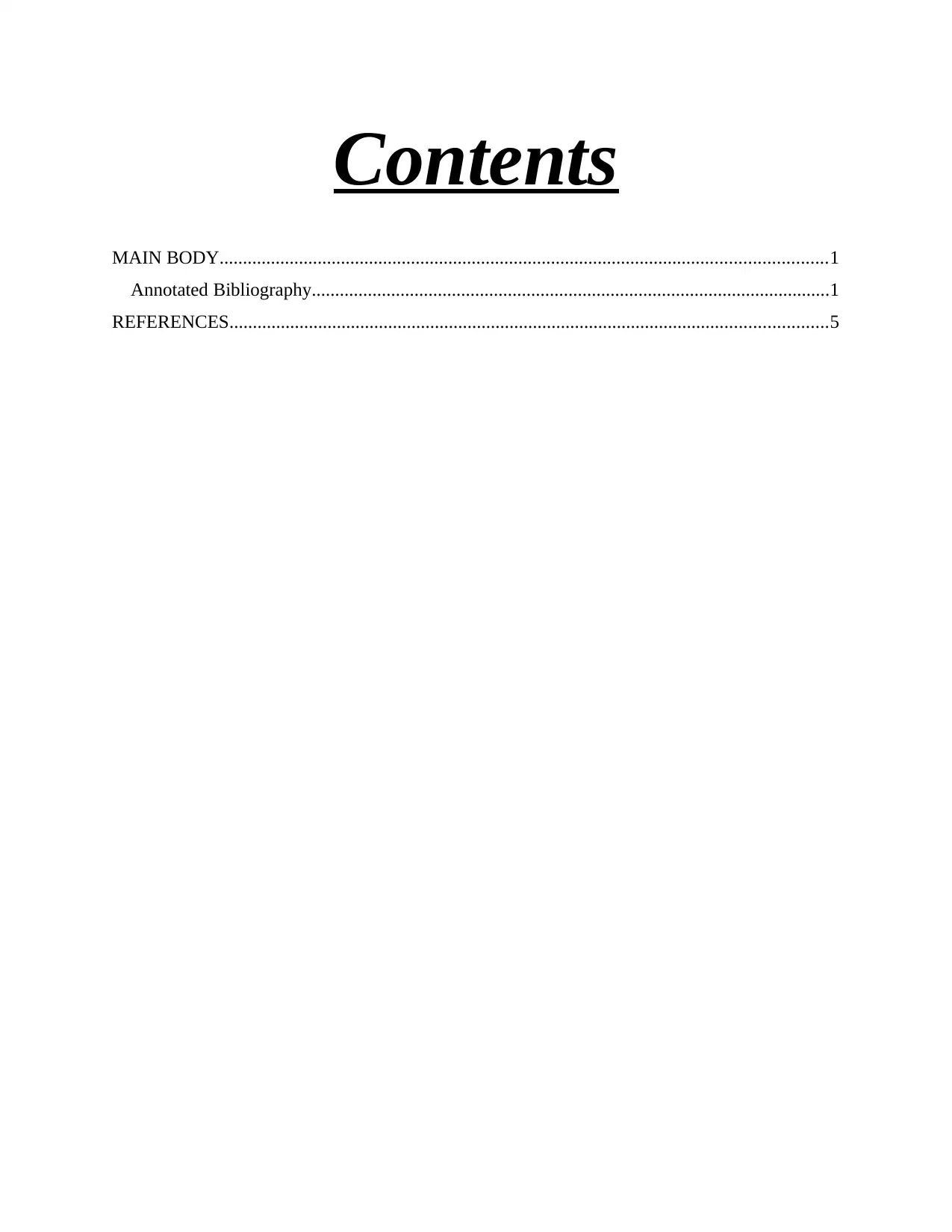
Contents
MAIN BODY..................................................................................................................................1
Annotated Bibliography...............................................................................................................1
REFERENCES................................................................................................................................5
MAIN BODY..................................................................................................................................1
Annotated Bibliography...............................................................................................................1
REFERENCES................................................................................................................................5
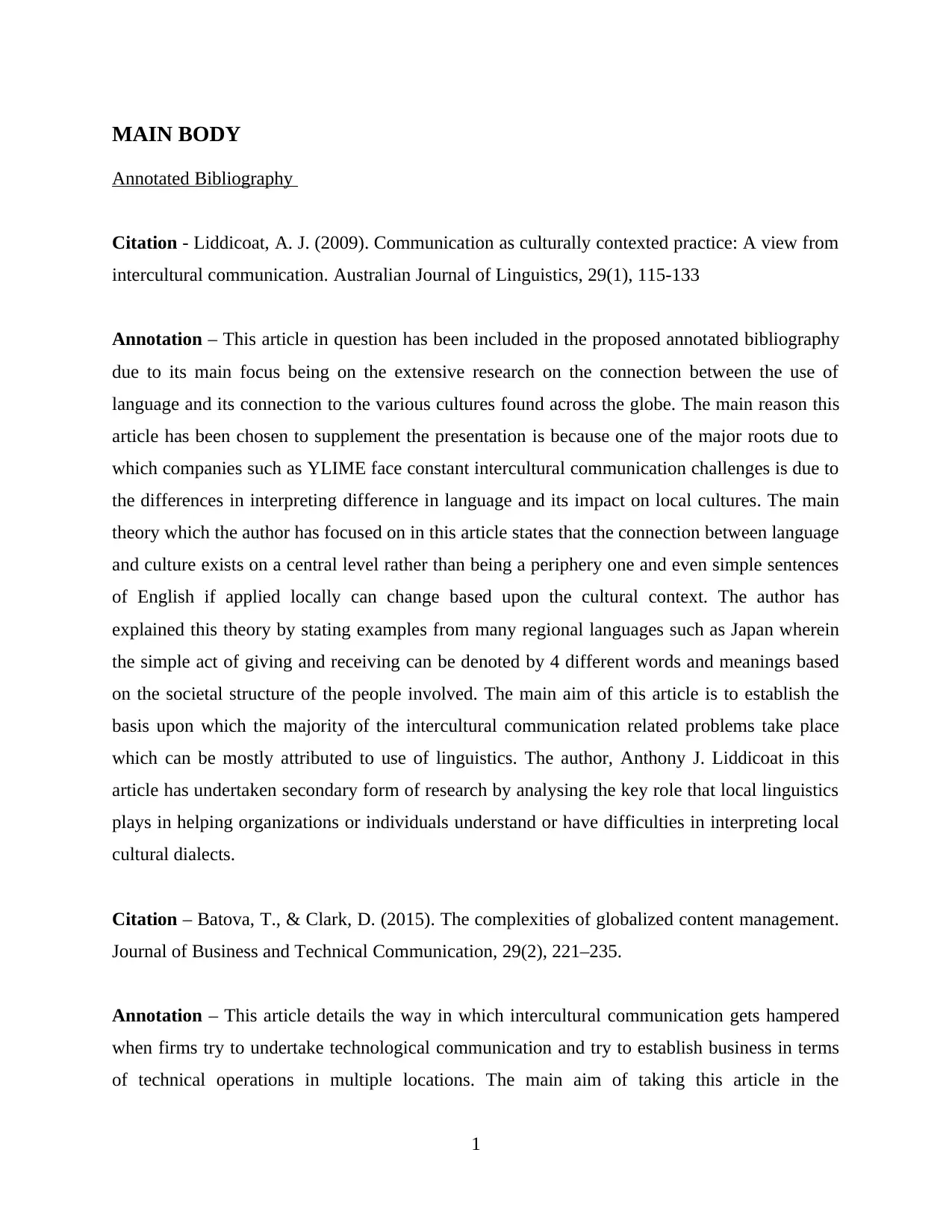
MAIN BODY
Annotated Bibliography
Citation - Liddicoat, A. J. (2009). Communication as culturally contexted practice: A view from
intercultural communication. Australian Journal of Linguistics, 29(1), 115-133
Annotation – This article in question has been included in the proposed annotated bibliography
due to its main focus being on the extensive research on the connection between the use of
language and its connection to the various cultures found across the globe. The main reason this
article has been chosen to supplement the presentation is because one of the major roots due to
which companies such as YLIME face constant intercultural communication challenges is due to
the differences in interpreting difference in language and its impact on local cultures. The main
theory which the author has focused on in this article states that the connection between language
and culture exists on a central level rather than being a periphery one and even simple sentences
of English if applied locally can change based upon the cultural context. The author has
explained this theory by stating examples from many regional languages such as Japan wherein
the simple act of giving and receiving can be denoted by 4 different words and meanings based
on the societal structure of the people involved. The main aim of this article is to establish the
basis upon which the majority of the intercultural communication related problems take place
which can be mostly attributed to use of linguistics. The author, Anthony J. Liddicoat in this
article has undertaken secondary form of research by analysing the key role that local linguistics
plays in helping organizations or individuals understand or have difficulties in interpreting local
cultural dialects.
Citation – Batova, T., & Clark, D. (2015). The complexities of globalized content management.
Journal of Business and Technical Communication, 29(2), 221–235.
Annotation – This article details the way in which intercultural communication gets hampered
when firms try to undertake technological communication and try to establish business in terms
of technical operations in multiple locations. The main aim of taking this article in the
1
Annotated Bibliography
Citation - Liddicoat, A. J. (2009). Communication as culturally contexted practice: A view from
intercultural communication. Australian Journal of Linguistics, 29(1), 115-133
Annotation – This article in question has been included in the proposed annotated bibliography
due to its main focus being on the extensive research on the connection between the use of
language and its connection to the various cultures found across the globe. The main reason this
article has been chosen to supplement the presentation is because one of the major roots due to
which companies such as YLIME face constant intercultural communication challenges is due to
the differences in interpreting difference in language and its impact on local cultures. The main
theory which the author has focused on in this article states that the connection between language
and culture exists on a central level rather than being a periphery one and even simple sentences
of English if applied locally can change based upon the cultural context. The author has
explained this theory by stating examples from many regional languages such as Japan wherein
the simple act of giving and receiving can be denoted by 4 different words and meanings based
on the societal structure of the people involved. The main aim of this article is to establish the
basis upon which the majority of the intercultural communication related problems take place
which can be mostly attributed to use of linguistics. The author, Anthony J. Liddicoat in this
article has undertaken secondary form of research by analysing the key role that local linguistics
plays in helping organizations or individuals understand or have difficulties in interpreting local
cultural dialects.
Citation – Batova, T., & Clark, D. (2015). The complexities of globalized content management.
Journal of Business and Technical Communication, 29(2), 221–235.
Annotation – This article details the way in which intercultural communication gets hampered
when firms try to undertake technological communication and try to establish business in terms
of technical operations in multiple locations. The main aim of taking this article in the
1
⊘ This is a preview!⊘
Do you want full access?
Subscribe today to unlock all pages.

Trusted by 1+ million students worldwide
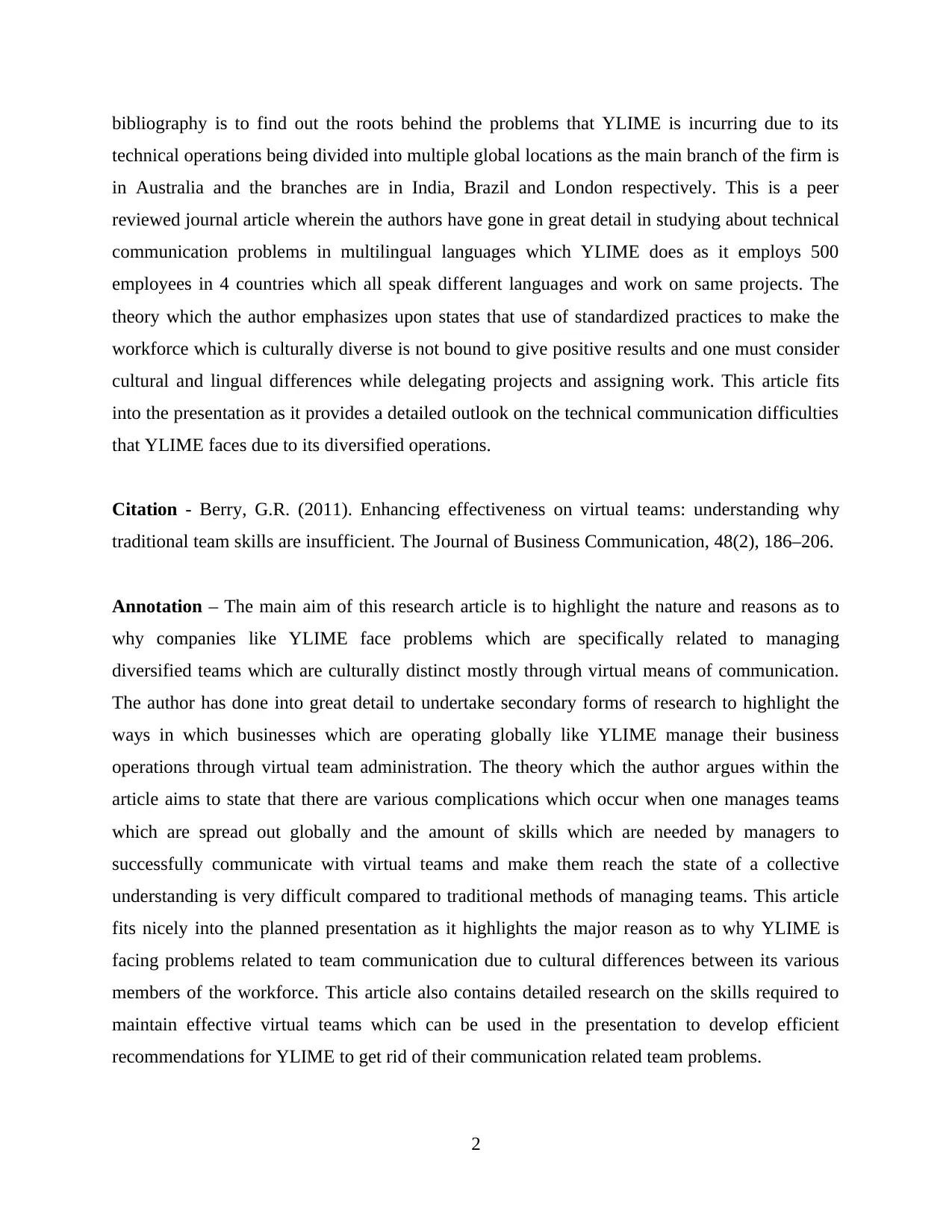
bibliography is to find out the roots behind the problems that YLIME is incurring due to its
technical operations being divided into multiple global locations as the main branch of the firm is
in Australia and the branches are in India, Brazil and London respectively. This is a peer
reviewed journal article wherein the authors have gone in great detail in studying about technical
communication problems in multilingual languages which YLIME does as it employs 500
employees in 4 countries which all speak different languages and work on same projects. The
theory which the author emphasizes upon states that use of standardized practices to make the
workforce which is culturally diverse is not bound to give positive results and one must consider
cultural and lingual differences while delegating projects and assigning work. This article fits
into the presentation as it provides a detailed outlook on the technical communication difficulties
that YLIME faces due to its diversified operations.
Citation - Berry, G.R. (2011). Enhancing effectiveness on virtual teams: understanding why
traditional team skills are insufficient. The Journal of Business Communication, 48(2), 186–206.
Annotation – The main aim of this research article is to highlight the nature and reasons as to
why companies like YLIME face problems which are specifically related to managing
diversified teams which are culturally distinct mostly through virtual means of communication.
The author has done into great detail to undertake secondary forms of research to highlight the
ways in which businesses which are operating globally like YLIME manage their business
operations through virtual team administration. The theory which the author argues within the
article aims to state that there are various complications which occur when one manages teams
which are spread out globally and the amount of skills which are needed by managers to
successfully communicate with virtual teams and make them reach the state of a collective
understanding is very difficult compared to traditional methods of managing teams. This article
fits nicely into the planned presentation as it highlights the major reason as to why YLIME is
facing problems related to team communication due to cultural differences between its various
members of the workforce. This article also contains detailed research on the skills required to
maintain effective virtual teams which can be used in the presentation to develop efficient
recommendations for YLIME to get rid of their communication related team problems.
2
technical operations being divided into multiple global locations as the main branch of the firm is
in Australia and the branches are in India, Brazil and London respectively. This is a peer
reviewed journal article wherein the authors have gone in great detail in studying about technical
communication problems in multilingual languages which YLIME does as it employs 500
employees in 4 countries which all speak different languages and work on same projects. The
theory which the author emphasizes upon states that use of standardized practices to make the
workforce which is culturally diverse is not bound to give positive results and one must consider
cultural and lingual differences while delegating projects and assigning work. This article fits
into the presentation as it provides a detailed outlook on the technical communication difficulties
that YLIME faces due to its diversified operations.
Citation - Berry, G.R. (2011). Enhancing effectiveness on virtual teams: understanding why
traditional team skills are insufficient. The Journal of Business Communication, 48(2), 186–206.
Annotation – The main aim of this research article is to highlight the nature and reasons as to
why companies like YLIME face problems which are specifically related to managing
diversified teams which are culturally distinct mostly through virtual means of communication.
The author has done into great detail to undertake secondary forms of research to highlight the
ways in which businesses which are operating globally like YLIME manage their business
operations through virtual team administration. The theory which the author argues within the
article aims to state that there are various complications which occur when one manages teams
which are spread out globally and the amount of skills which are needed by managers to
successfully communicate with virtual teams and make them reach the state of a collective
understanding is very difficult compared to traditional methods of managing teams. This article
fits nicely into the planned presentation as it highlights the major reason as to why YLIME is
facing problems related to team communication due to cultural differences between its various
members of the workforce. This article also contains detailed research on the skills required to
maintain effective virtual teams which can be used in the presentation to develop efficient
recommendations for YLIME to get rid of their communication related team problems.
2
Paraphrase This Document
Need a fresh take? Get an instant paraphrase of this document with our AI Paraphraser
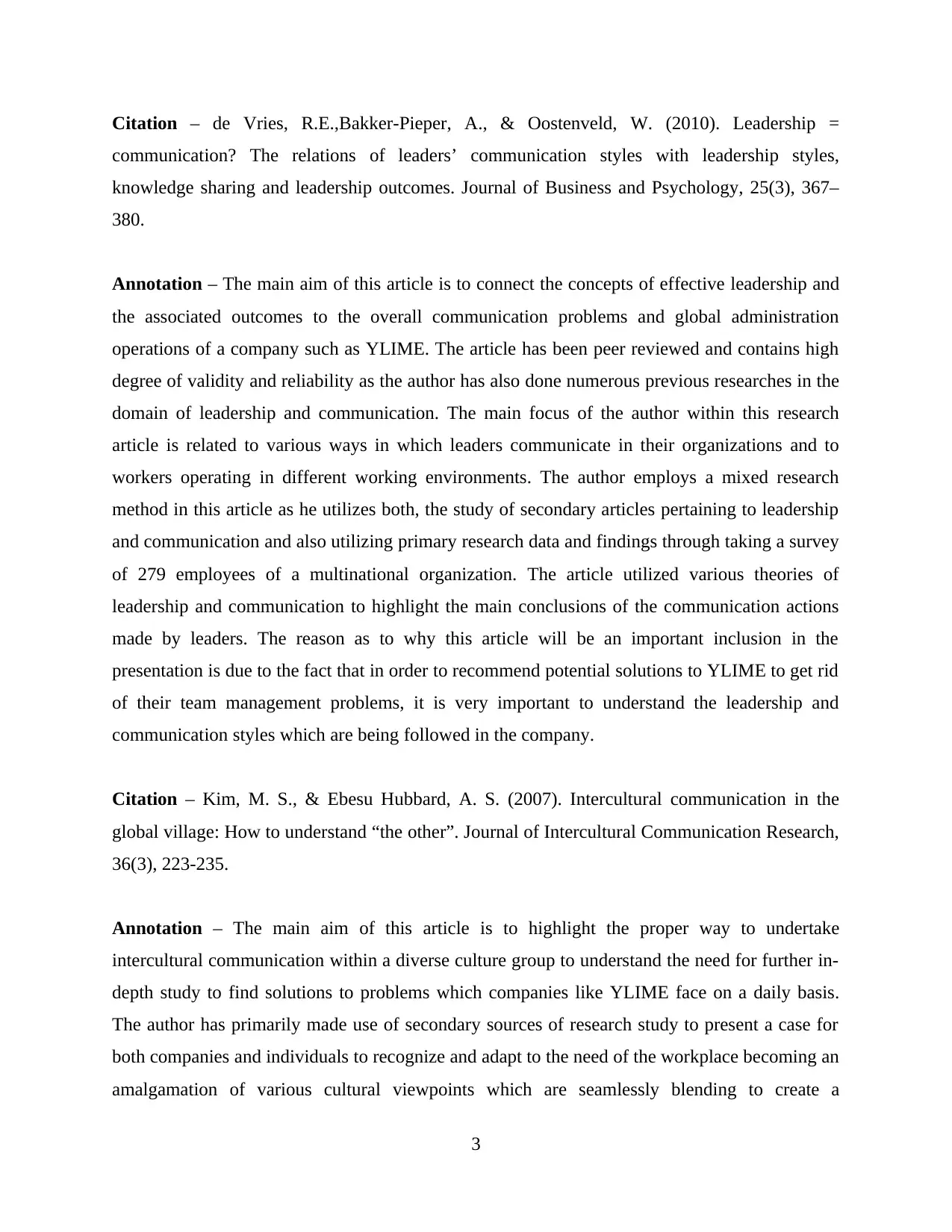
Citation – de Vries, R.E.,Bakker-Pieper, A., & Oostenveld, W. (2010). Leadership =
communication? The relations of leaders’ communication styles with leadership styles,
knowledge sharing and leadership outcomes. Journal of Business and Psychology, 25(3), 367–
380.
Annotation – The main aim of this article is to connect the concepts of effective leadership and
the associated outcomes to the overall communication problems and global administration
operations of a company such as YLIME. The article has been peer reviewed and contains high
degree of validity and reliability as the author has also done numerous previous researches in the
domain of leadership and communication. The main focus of the author within this research
article is related to various ways in which leaders communicate in their organizations and to
workers operating in different working environments. The author employs a mixed research
method in this article as he utilizes both, the study of secondary articles pertaining to leadership
and communication and also utilizing primary research data and findings through taking a survey
of 279 employees of a multinational organization. The article utilized various theories of
leadership and communication to highlight the main conclusions of the communication actions
made by leaders. The reason as to why this article will be an important inclusion in the
presentation is due to the fact that in order to recommend potential solutions to YLIME to get rid
of their team management problems, it is very important to understand the leadership and
communication styles which are being followed in the company.
Citation – Kim, M. S., & Ebesu Hubbard, A. S. (2007). Intercultural communication in the
global village: How to understand “the other”. Journal of Intercultural Communication Research,
36(3), 223-235.
Annotation – The main aim of this article is to highlight the proper way to undertake
intercultural communication within a diverse culture group to understand the need for further in-
depth study to find solutions to problems which companies like YLIME face on a daily basis.
The author has primarily made use of secondary sources of research study to present a case for
both companies and individuals to recognize and adapt to the need of the workplace becoming an
amalgamation of various cultural viewpoints which are seamlessly blending to create a
3
communication? The relations of leaders’ communication styles with leadership styles,
knowledge sharing and leadership outcomes. Journal of Business and Psychology, 25(3), 367–
380.
Annotation – The main aim of this article is to connect the concepts of effective leadership and
the associated outcomes to the overall communication problems and global administration
operations of a company such as YLIME. The article has been peer reviewed and contains high
degree of validity and reliability as the author has also done numerous previous researches in the
domain of leadership and communication. The main focus of the author within this research
article is related to various ways in which leaders communicate in their organizations and to
workers operating in different working environments. The author employs a mixed research
method in this article as he utilizes both, the study of secondary articles pertaining to leadership
and communication and also utilizing primary research data and findings through taking a survey
of 279 employees of a multinational organization. The article utilized various theories of
leadership and communication to highlight the main conclusions of the communication actions
made by leaders. The reason as to why this article will be an important inclusion in the
presentation is due to the fact that in order to recommend potential solutions to YLIME to get rid
of their team management problems, it is very important to understand the leadership and
communication styles which are being followed in the company.
Citation – Kim, M. S., & Ebesu Hubbard, A. S. (2007). Intercultural communication in the
global village: How to understand “the other”. Journal of Intercultural Communication Research,
36(3), 223-235.
Annotation – The main aim of this article is to highlight the proper way to undertake
intercultural communication within a diverse culture group to understand the need for further in-
depth study to find solutions to problems which companies like YLIME face on a daily basis.
The author has primarily made use of secondary sources of research study to present a case for
both companies and individuals to recognize and adapt to the need of the workplace becoming an
amalgamation of various cultural viewpoints which are seamlessly blending to create a
3
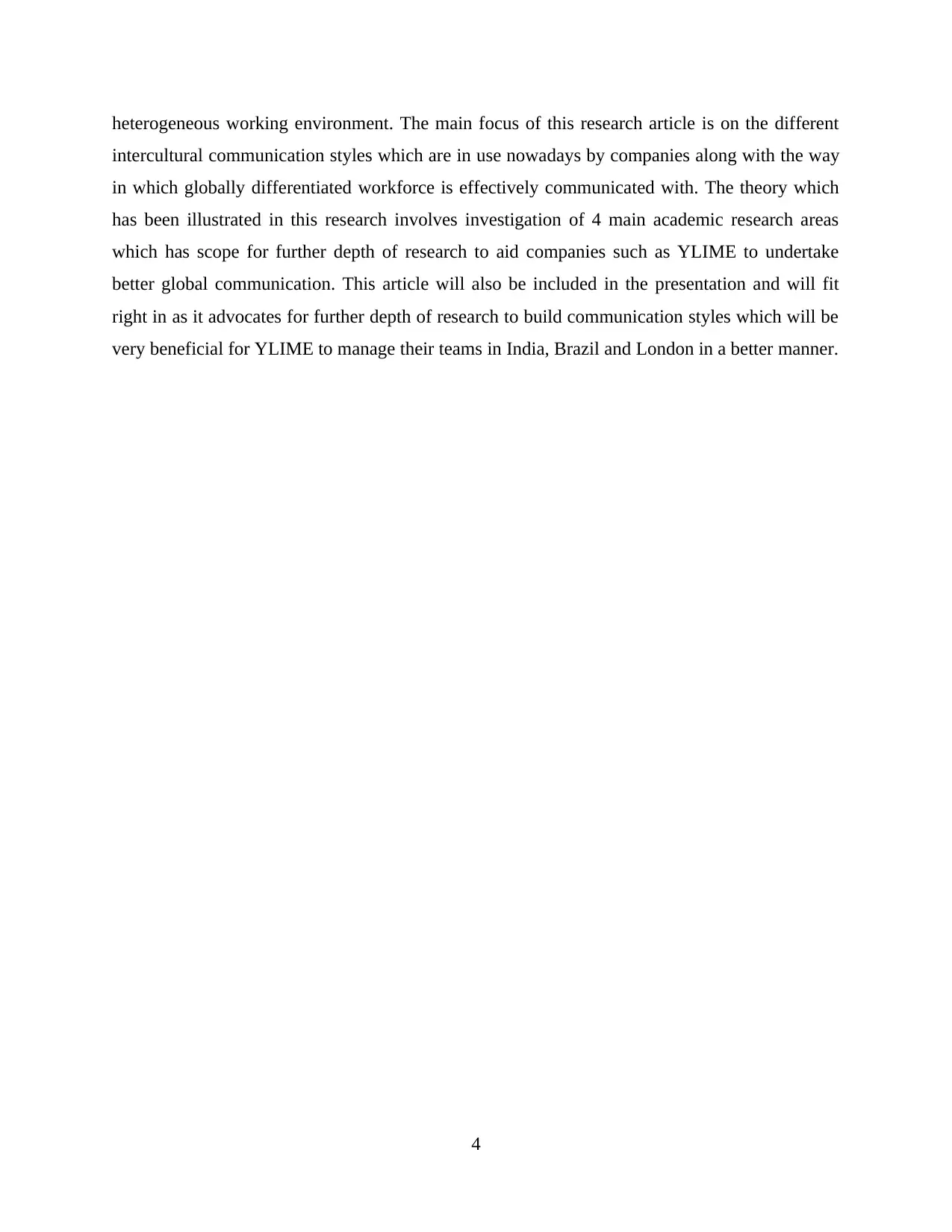
heterogeneous working environment. The main focus of this research article is on the different
intercultural communication styles which are in use nowadays by companies along with the way
in which globally differentiated workforce is effectively communicated with. The theory which
has been illustrated in this research involves investigation of 4 main academic research areas
which has scope for further depth of research to aid companies such as YLIME to undertake
better global communication. This article will also be included in the presentation and will fit
right in as it advocates for further depth of research to build communication styles which will be
very beneficial for YLIME to manage their teams in India, Brazil and London in a better manner.
4
intercultural communication styles which are in use nowadays by companies along with the way
in which globally differentiated workforce is effectively communicated with. The theory which
has been illustrated in this research involves investigation of 4 main academic research areas
which has scope for further depth of research to aid companies such as YLIME to undertake
better global communication. This article will also be included in the presentation and will fit
right in as it advocates for further depth of research to build communication styles which will be
very beneficial for YLIME to manage their teams in India, Brazil and London in a better manner.
4
⊘ This is a preview!⊘
Do you want full access?
Subscribe today to unlock all pages.

Trusted by 1+ million students worldwide
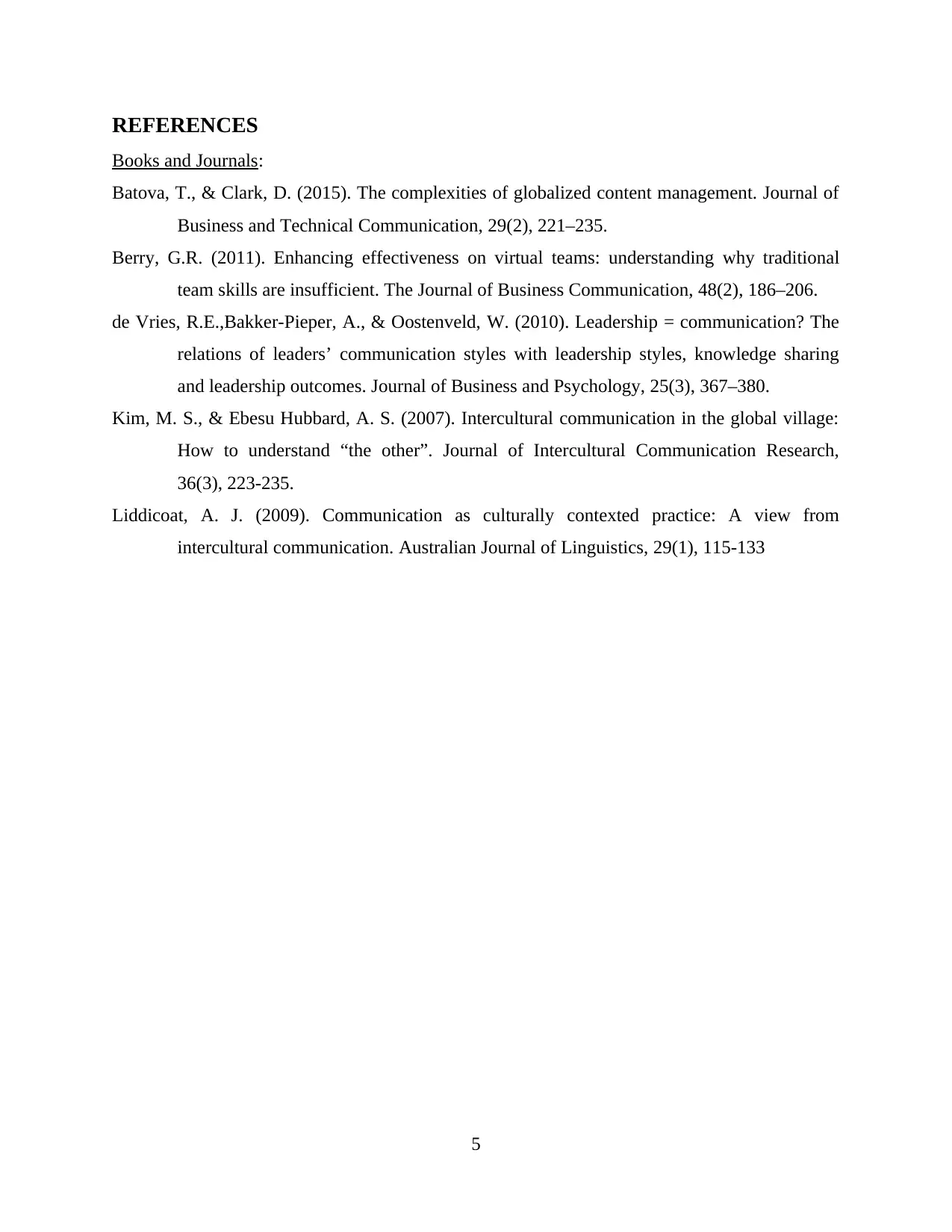
REFERENCES
Books and Journals:
Batova, T., & Clark, D. (2015). The complexities of globalized content management. Journal of
Business and Technical Communication, 29(2), 221–235.
Berry, G.R. (2011). Enhancing effectiveness on virtual teams: understanding why traditional
team skills are insufficient. The Journal of Business Communication, 48(2), 186–206.
de Vries, R.E.,Bakker-Pieper, A., & Oostenveld, W. (2010). Leadership = communication? The
relations of leaders’ communication styles with leadership styles, knowledge sharing
and leadership outcomes. Journal of Business and Psychology, 25(3), 367–380.
Kim, M. S., & Ebesu Hubbard, A. S. (2007). Intercultural communication in the global village:
How to understand “the other”. Journal of Intercultural Communication Research,
36(3), 223-235.
Liddicoat, A. J. (2009). Communication as culturally contexted practice: A view from
intercultural communication. Australian Journal of Linguistics, 29(1), 115-133
5
Books and Journals:
Batova, T., & Clark, D. (2015). The complexities of globalized content management. Journal of
Business and Technical Communication, 29(2), 221–235.
Berry, G.R. (2011). Enhancing effectiveness on virtual teams: understanding why traditional
team skills are insufficient. The Journal of Business Communication, 48(2), 186–206.
de Vries, R.E.,Bakker-Pieper, A., & Oostenveld, W. (2010). Leadership = communication? The
relations of leaders’ communication styles with leadership styles, knowledge sharing
and leadership outcomes. Journal of Business and Psychology, 25(3), 367–380.
Kim, M. S., & Ebesu Hubbard, A. S. (2007). Intercultural communication in the global village:
How to understand “the other”. Journal of Intercultural Communication Research,
36(3), 223-235.
Liddicoat, A. J. (2009). Communication as culturally contexted practice: A view from
intercultural communication. Australian Journal of Linguistics, 29(1), 115-133
5
1 out of 7
Related Documents
Your All-in-One AI-Powered Toolkit for Academic Success.
+13062052269
info@desklib.com
Available 24*7 on WhatsApp / Email
![[object Object]](/_next/static/media/star-bottom.7253800d.svg)
Unlock your academic potential
Copyright © 2020–2025 A2Z Services. All Rights Reserved. Developed and managed by ZUCOL.



